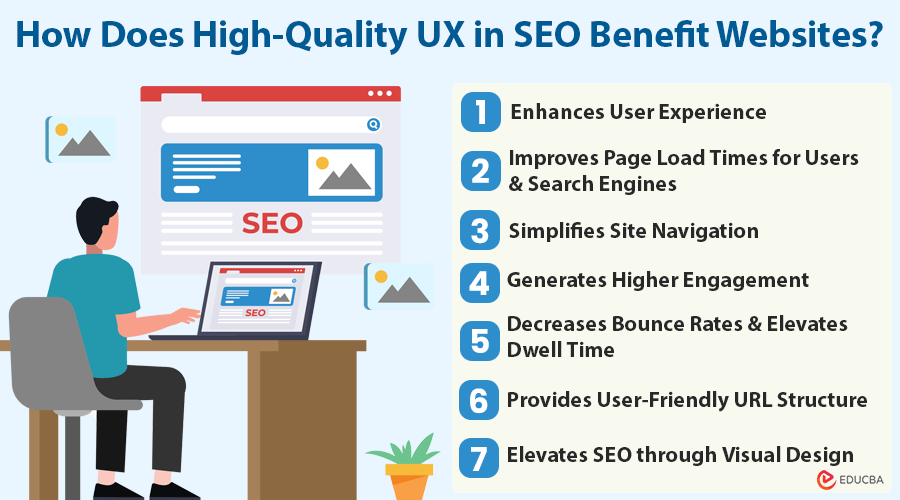
UX in SEO Meaning
UX in SEO stands for ‘User Experience’ in ‘Search Engine Optimization’. It refers to how a user’s overall experience on your website impacts your site’s ranking on search engines like Google.
A good UX means that your site is easy to navigate, loads quickly, is mobile-friendly, and provides valuable content. These factors can significantly boost your search results.
This post aims to show that UX and SEO are not separate or competing fields but are interconnected parts of attracting traffic, engaging visitors, and achieving conversion goals.
Why UX in SEO Matters?
Gerrid Smith, Founder and CEO of Fortress Growth, states, “UX and SEO share the goal of providing users with the best possible experience. A well-optimized website with a great user experience is likely to rank higher on search engines, attracting more visitors.”
UX focuses on website navigation ease, accessibility, and user satisfaction. On the other hand, SEO ensures that users can easily locate the website through search engines. Thus, when both UX and SEO are optimized, they can attract visitors, reduce bounce rates, and improve visibility.
How Does High-Quality UX in SEO Benefit Websites?
Websites can enjoy several benefits of improving UX in SEO. Here are a few:
1. Enhances User Experience
As mobile and tablet usage has increased, all websites need to work well on these devices. It means your website is mobile-responsive. Moreover, Google first checks how well a website works on mobile devices. If a website is mobile-friendly, it offers a good experience for users on any device, which can lead to higher search rankings.
Stuart Broad, Marketing Manager at First Aid Training For Schools, explains, “Mobile responsiveness means a website adapts to different screen sizes and improves user experience. It helps reduce bounce rates. Optimized mobile layouts also improve loading times, enhancing user experience and SEO.”
2. Improves Page Load Times for Users and Search Engines
How fast a webpage loads is also very crucial. Users like fast-loading sites, and they often leave a website quickly if it takes too long to load. It can increase the website’s bounce rate too. Google considers page load speed when deciding rankings. Techniques like optimizing images, using caching, and reducing JavaScript and CSS files can enhance both UX and SEO.
Daniel Foley, Founder of Daniel Foley SEO Consultancy, emphasizes, “A fast-loading website retains visitors and sends positive signals to search engines. Tools like Google PageSpeed Insights help identify inefficiencies and optimize page load times, improving SEO and user satisfaction.”
3. Simplifies Site Navigation
Clear website navigation and a well-structured site are vital for both user satisfaction and SEO success. Easy navigation reduces user frustration, increases engagement, and indicates to search engines that your content is valuable. A logical site structure allows search engines to understand and index your content efficiently, potentially boosting your search rankings.
Youssef Hodaigui, Founder of Mindflow Marketing, advises, “Equip your site with intuitive navigation and a clear structure. Improving search engine rankings becomes easier and user experience gets better when content is more accessible and indexable.”
4. Generates Higher Engagement
Creating high-quality and appropriate content is important for engaging users and enhancing SEO. When your users relate to your content, they stay on your site longer and might even share it. This sharing can lead to more backlinks and positive signals for search engines, ultimately boosting your site’s visibility and ranking in search results.
Derek Bruce, Director of the Mental Health First Aid Course, suggests, “Deliver engaging and informative content that meets your audience’s needs. Use blogs, articles, videos, and infographics to enhance user interaction and improve SEO rankings.”
5. Decreases Bounce Rates and Elevates Dwell Time
Various analytics tools, like Google Analytics, show how users use your site. If they visit often and stay longer, they like it. Such websites have low bounce rates and longer dwell times (time spent engaging with your content).
High bounce rates mean users leave early, usually due to bad UX, like slow loading. Improving UX with easy navigation and good content reduces bounce rates and increases dwell time, helping your site rank higher on Google.
Tim Parker, Director at Syntax Integration, notes, “Reduce bounce rates by making your site attractive and eliminating unwanted ads. Increase dwell time by offering engaging content and interactive elements. These efforts improve user satisfaction and signal to search engines that your site is valuable.”
6. Provides User-Friendly URL Structure
SEO-friendly URLs are clean and easy to understand. They assist both users and search engines in understanding the page’s content. Short, informative URLs that reflect the page title or keywords improve click-through rates and crawlability.
Paul Phelps, Managing Director at SOLENT POWER, advises, “Use short, descriptive URLs without special characters, and separate words with hyphens. It enhances readability and SEO rankings.”
7. Elevates SEO through Visual Design
The visual design significantly impacts user experience. A visually appealing and well-organized website can attract attention. While visual appeal is not a direct SEO ranking factor, it influences user interaction, indirectly affecting SEO.
Adam Crossling, Marketing & New Business Director at Zenzero, says, “Consistent colors, high-quality images, and a neat layout improve user engagement. A visually appealing design that enhances accessibility and usability can boost both UX and SEO.”
Final Thoughts
Integrating UX and SEO principles is essential for surviving online competition. This symbiotic approach ensures websites remain relevant and beneficial to their audiences.
To excel in SEO, organizations must prioritize user engagement and search experience. It involves mobile-friendly designs, fast loading times, high-quality content, intuitive navigation, and appealing layouts.
Recommended Articles
For more articles similar to “UX in SEO” that guide you in optimizing your website for better search engine rankings, explore the following resources.
